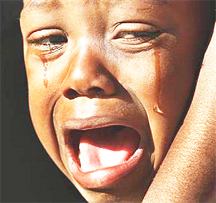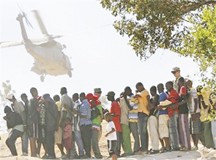PORT-AU-PRINCE, (Reuters) – Rescuers pulled two barely alive survivors from the rubble of Port-au-Prince yesterday as hungry and homeless Haitians clamoured for food, which was slow in arriving 10 days after the massive earthquake.

An 84-year-old woman was pulled from under a wrecked building yesterday, the doctor who treated her said.
“They pulled her out early this morning. She was barely responding, she had wounds all over her body, and maggots,” said Dr Vladimir Larouche, a Haitian-American doctor from New York, working at Port-au-Prince General Hospital.
“I treated her and made her stable. The (U.S.) army evacuated her to a boat,” he told Reuters.
Elsewhere in the shattered capital, an Israeli rescue team freed a 22-year-old man from the rubble. Rescuers and local residents hugged and celebrated after pulling out the man, who was limp and suffering from dehydration.
Although aid from around the world has been pouring into the wrecked city in a huge U.S.-led relief operation, quake survivors camped out in the rubble-strewn streets still complained bitterly that they were not receiving food.
“We are hungry, we are thirsty, we can’t stand it anymore. We want food, we want water. Down with Preval. Long live Obama,” shouted a group of protesters outside the police station where President Rene Preval’s government is operating.

Police pushed back the few dozen protesters.
Preval, whose own presidential palace and home collapsed in the Jan. 12 quake that killed up to 200,000 people, said his government and international partners were doing everything possible to get assistance to the hundreds of thousands of needy survivors.
“We are not sitting idle doing nothing. I know the scale of the problem and how people are suffering,” he said.
U.S. President Barack Obama has sent in a large military task force to spearhead the international relief efforts.
Up to 1.5 million Haitians lost their homes in the earthquake that rocked the poor Caribbean country.
Relief agencies estimated one-third of Haiti’s 9 million people would need emergency food, water and shelter for an extended period.
“We can do this 24 hours a day for the next six months and we still won’t meet the need,” said First Sergeant Rob Farnsworth, part of a U.S. Army airborne unit handing out food packs at a squalid camp where survivors lived in the open air.
SOME SIGNS OF DAILY LIFE
There were some signs of daily life resuming. Taptaps, Haiti’s small, colorfully decorated private buses, circulated in Port-au-Prince, sharing streets with the earth-movers and digging machines clearing debris.
Banks were scheduled to reopen today and money transfer agencies did brisk business after opening yesterday.
“I want to get some cash sent by my family from Canada. It’s $500 but it’s difficult. There are so many people,” said businessman Aslyn Denis, 31, waiting in a line with hundreds of people, some of them jostling each other, outside a Unitransfer office.
The dead body of a young man lay in a street, his head swollen and bloody. Residents said he tried to steal money and was stoned by a crowd. He wore socks but his shoes were gone and his pockets had been pulled out.
Edmond Mulet, acting head of the U.N. peacekeeping mission in Haiti, said coordination in delivering aid was getting better every day. But Henriette Chamouillet, the World Health Organization representative in Haiti, said it remained a problem.
She said the Haitian prime minister complained at a morning meeting with aid workers that only 10 percent of the population in makeshift camps had received any food aid while some camps had received three times the amount of food they needed.
Nearly 1,000 hungry people swarmed a U.S. military truck as an 82nd Airborne company known as “the Beast” handed out food and water at an encampment on a soccer field. Overwhelmed, the troops pulled out after distributing 600 packaged meals, leaving 250 food packs still on the truck.
A large supermarket, Big Star Market, reopened in the Petionville suburb on Friday, selling everything from slabs of ham and goat meat to Valentine’s Day chocolates. But the store manager said they had only a week or two of stocks left and had received no deliveries.
U.S. Navy helicopters ferried in boxes of water to distribute to Haitians lined up at a sprawling survivors’ camp that covered a golf course. Actor Sean Penn stopped by to deliver antibiotics, painkillers and water filters. “The whole city has collapsed,” he said.
U.S. troops were giving away 50,000 solar- and crank-powered radios to help displaced Haitians receive announcements telling them where aid was available.
More than 13,000 U.S. military personnel are in Haiti and on ships offshore, flying in supplies, evacuating the seriously wounded and protecting aid distribution points. The United Nations is adding 2,000 troops and 1,500 police to its 9,000-member peacekeeping mission.
MILLIONS PLEDGED
More than $1.2 billion has been pledged to help rebuild roads, government buildings and homes, but the World Bank said much more would be needed to get Haiti on its feet.
“My anticipation is that $1.2 billion is just the floor,” the bank’s director for the Caribbean, Yvonne Tsikata, told France 24 television.
The International Monetary Fund urged donors gathering in Montreal tomorrow to adopt a Marshall Plan for Haiti, similar to the U.S. effort that helped rebuild Europe after World War Two. “It is not unrealistic to imagine that the country can be rebuilt as a prosperous nation. But it needs help over a prolonged period,” IMF Managing Director Dominique Strauss-Kahn wrote on the Huffington Post website.
Haitians are realizing it could take months or years to regain some sense of normalcy.
“We want it to be over, but it’s not finished yet, things are bad,” said Jeanette, a 53-year-old architect shopping at the Big Star Market. “We have no stability, no direction, we’ve been left to fend for ourselves. We can’t plan for the future, we’re just living day-to-day.”
